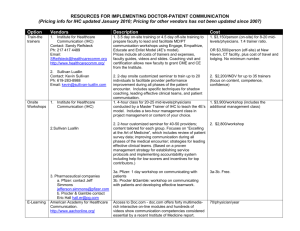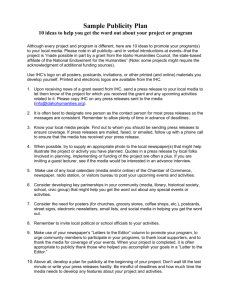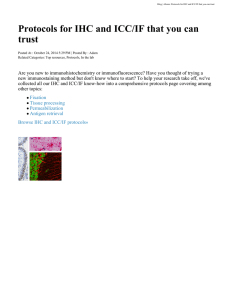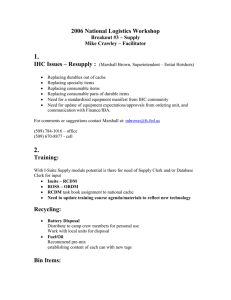Wired for Health Future Research Sarah N. Keller
advertisement
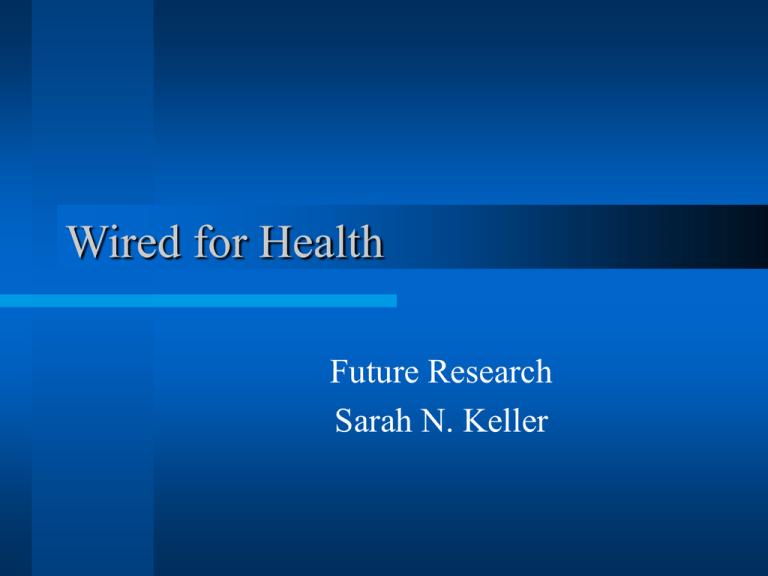
Wired for Health Future Research Sarah N. Keller Internet Health Communication IHC Panel Definitions Background Specific Aims Risks & Benefits – internet’s potential – benefits & risks of IHC – need for data on effectiveness Project Design Science Panel on IHC U.S. Dept. Health & Human Services Aug. 1999 Office of Disease Prevention & Health Promotion of U.S. Department of Health & Human Services – Convened Science Panel on IHC in 1996 – 14-member, non-Federal experts in health & technology – Panel met 10 times over 2-1/2 years – To summarize risks & benefits of IHC Science Panel on IHC Recommended Strategies Strengthen evaluation and quality Improve basic knowledge and understanding of IHC Enhance capacity of stakeholders to develop and use IHC Improve access for all populations Science Panel on IHC Improving Evaluation To improve evaluation, Internet health communicators should: – integrate evaluation methods into their products – disclose info on how applications are evaluated for effectiveness – adopt voluntary quality standards Science Panel on IHC Improving Basic Knowledge Identify gaps in knowledge & priority areas for research, application development, demonstration projects Establish interagency initiative to coordinate state & federal funding Set up long-term initiative to monitor social impact Monitor trends in policy that affects Internet health interventions Ensure privacy Science Panel on IHC Enhance Capacity for Use Set up clearinghouse – of public domain objects, tools, raw materials & info resources Academic-industry collaboration Improve public literacy in health technology Health providers should receive IHC training Performance indicators Models – Process, organizational and financial Science Panel on IHC Improve Access Public & professional education – About availability of IHC applications Public-private initiatives to enhance access among underserved Models – For development of applications for underserved Definitions Integrated (or Internet) health communication - the interaction of an individual with/through an electronic communications device to access or transmit health information. Eng & Gustafson, 1999. Science Panel on Interactive Communication and Health. Washington: US Dept. Health and Human Services. Definitions (cont’d) IHC applications – Software or modules used to interface with users rather than hardware and infrastructure. IHC (here) does NOT refer to applications for financial, administrative or data functions. Significance Public Health – disseminating info, health prevention – online peer support New Media Research – theory development – understanding processes Private Marketing Public Policy – Environmental & Education Goals Background – Info Tech 1997 - information technology largest industry in US 1996 – 33% of growth in GDP 1988 - 8% of U.S. homes w/ PCs 1998 - 45% of U.S. homes w/ PCs 1997 - 50% of users obtained health info via computer Background – Health Care 1990 – 36.5 million Americans in managed care 1996 – 67.5 million 1999 – 29% of all Americans look for health information on the Web. – 70% do so before seeing a health care professional 2000 - Health info is 2nd most common use of WWW Cyberatlas, 2000; Gervey & Lin, 2000; Sutton, Brown, Wilson & Klein, 1999; Weiler & Pealer, 2000 Background “There are 2 main reasons why people like to buy prescription drugs and supplements on the Internet. The first is that they can be less expensive, the second that they can sometimes be ordered nearly anonymously.” – Carol Rollins, MS, RD, PharmD, a pharmacist from Tucson, AZ. For-profit initiatives WellMed Personal Health Manager – www.behavioralhealthonline.com enables users to assess, record and improve their health on a daily basis. – online health management tools enable individuals to check their health status, store personal health records securely, identify risks and access accurate, information – WellMed, Inc., founded in 1993, is the leading provider of online consumer health management products Examples: Information Relay information – – Online services, telephone-based systems, Web sites provide individualized health info on demand – Greenfield, et al., 1985 showed access to health info enabled patients to be more active participants in their care and led to better health outcomes Buhle, et al., 1994; Meyer, 1996; Barry, et al., 1995 Example: Decision-making Informed decision-making – Assist individuals w/ health care decisions – Shared d-making programs improved outcomes of surgery Examples: Risk assessment Risk-assessment and health promotion modules based on theories of behavior change – Self-assessment tools can increase sense of control & focus in a health situation – Can increase self-efficacy – most predictive indicator of patients’ functional status Strecher, et al., 1994; Ferguson, 1996; O’Leary, 1985 Examples: Online support groups – Empower patients by increasing connection to others • Feeling in control is associated w/ health outcomes – Enable individuals to share info, give support, for specific conditions – Online support groups had positive impact on breast cancer & AIDS patients • Brennan, et al., 1995, used electronic support groups 2/week for Alzheimer’s caregivers • Cocaine-using pregnant women used electronic services 3/week over 7 mos. Gustafson, et al., 1993, 1994; McTavish, et al., 1994;Alemi, et al., 1996. Example: Online counseling Some data suggest patients prefer online counseling vs. face-to-face – Recovering substance abuse patients given access to both, 30% came to outpatient treatment and 87% accessed online treatment in 1998 – Postpartum mothers were 8 times more likely to use electronic support groups Mosavel, 1998; Alemi, et al., 1996 Examples: Self-care Self-care – Internet has been shown to increase selfmanagement of problems, esp. where access to care is limited – Self-care books provided to members of HMO reduced office visits & specialty referrals – By preparing patients for visits, interventions have improved treatment outcome for chronic diseases Vickery, et al., 1988; Greenfield & Kaplan, 1985. Call for Research Little is known about how to use the Internet to promote educational goals including sexual health Specific Aims This project aims to develop a general strategy for evaluating Web interventions to prevent STDs and HIV infection – using the American Social Health Association teen web site (http://www.iwannaknow.org) as a case study. Research Questions Research Question #1: What situations motivate teenagers to come to the web for sexual health information? Methods: content analysis, online survey Research Question #2: How do teenagers search for information on STDs? What search strategies do they use? How do they interact with web information? Methods: user testing Research Questions (cont’d) Research Question #3: How do KAP variables concerning STD prevention of teenagers exposed to the ASHA teen web site compare to teenagers who have not visited the site? Methods: national field experiment Research Question #4: What is the most effective way to evaluate a sexual health web site targeted at teenagers? Methods: user testing, online survey, national field experiment Risks & benefits Internet’s potential Benefits & risks of IHC Need for data on effectiveness Theories Internet’s Potential Internet important sex educator – Frequent sexual portrayals – Reticence of other sources of info More than half of teens learn about sex from mass media Teens report using Internet for sexual info - although #’s are small Kaiser Family Foundation, 1998; Sutton, Brown, Wilson & Klein, 1999 Internet’s Potential Unregulated content – Communication Decency Act of 1996 declared unconstitutional Intermediate status between a mass and interpersonal communication – Far-reaching, like a mass medium, yet interactive, like a conversation Allows audience segmentation Benefits of IHC Individualized health info (tailoring) Broader choices for users Anonymity (potential) Access on demand Social support Widespread dissemination Risks of IHC Misinformation & Malpractice – Although the Internet may improve patients' access to medical information and other medical services, Internet-based services involving the direct sale of medications, bypass protections normally associated with conventional medical practices. – May 1999, Dr Leandro Pasos, an orthopedic surgeon, accused of unprofessional conduct by the Washington State Health Department for prescribing sildenafil (Viagra) over the Internet to patients he had neither seen nor examined. Risks (cont’d) Malpractice – – Jan. 2000, Clinton’s new budget proposal inlcuded seek $10m to hire 100 people and upgrade computer technology to investigate websites suspected of illegally dispensing prescription drags. – Online drug stores will be required to get approval from the Food and Drug Administration (FDA) and to comply with state regulations on the practice of medicine and pharmacy Risks (cont’d) Regulation – The AMA and the National Association of Boards of Pharmacy are working together to develop a program to identify legitimate sites: • Verified Internet Pharmacy Practice Sites Risks (cont’d) Damage to client-provider relationship Violations of privacy Wasted resources Lack of access Barriers to IHC Provider resistance Lack of financial incentives Lack of access Implementation & maintenance costs Lack of data on effectiveness Theories Pertinent to IHC Outcome expectations – Social Learning Theory – Theory of Reasoned Action Self-efficacy expectations – Social Cognitive Theory Stages of Behavior Change Prochaska, et al., 1992; Bandura, 1986; Azjen & Fishbein, 1980; Bandura, 1977 ASHA Teen Web Site Employs Theories Social Learning Theory & Social Cognitive Theories – a role model, a young adult with extensive STD prevention counseling experience, is used to moderate message board – listing frequently asked questions from other teenagers – using tone of voice appropriate to teenagers ASHA Teen Web Site Employs Theories (cont’d) Stages of Behavior Change – different components of Web site • question-and-answer format; Internet games about safe sex negotiation and STD prevention; message boards; FAQs; etc. – teens can click on topics most appropriate Self-efficacy – Web diaries designed to give teenagers confidence in discussing, negotiating and practicing safe sex Project Design Phase I: content analysis – provide researchers with coding categories to evaluate the current site, and framework for the study. Phases II: user testing – direct observation and self-reports to study teenagers’ navigational tactics, search strategies, and page selections Project Design (cont’d) Phase III: online survey – convenience sample of teenagers (n=200) – online questionnaire about why they came to the Internet, and how they arrived Phase IV: national field experiment – test effects on STD prevention knowledge, attitudes, skills and behavioral intentions among a national sample of teenagers (n=1200) Expected Outcomes Develop an evaluation strategy – which can be generally applied to educational web sites – simple, easy-to-use plan Dissemination – online summary of results & study Benefits to society – sharing of results & strategy

